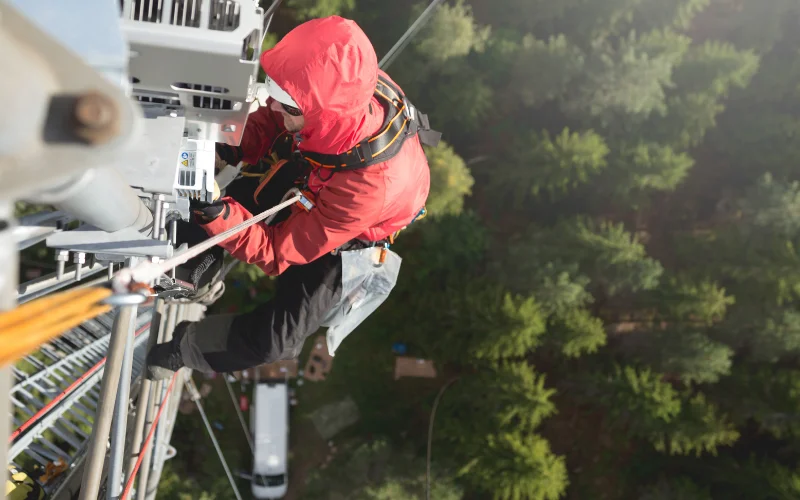Fear of heights, also known as acrophobia, is a common phobia that affects millions of people worldwide. This intense fear can significantly impact daily life, making activities such as climbing stairs, crossing bridges, or even looking out of a window a daunting task. For some, the fear can be so overwhelming that it leads to avoidance behaviors, limiting personal and professional opportunities. Understanding the root causes, symptoms, and effective strategies to manage and overcome this fear is crucial for leading a fulfilling life.
In this article, we will explore various aspects of the fear of heights, from its underlying causes to practical tips for managing it. We will also delve into related mental health challenges, such as scopophobia (fear of being stared at), that often accompany acrophobia. Whether you’re looking for therapeutic approaches or everyday coping mechanisms, this comprehensive guide aims to provide valuable insights and actionable steps to help you conquer your fear of heights.
Key Takeaways
- Overcoming the fear of heights requires understanding its root causes, recognizing symptoms, and implementing effective strategies.
- Cognitive-behavioral therapy (CBT) and exposure therapy are highly effective in managing and reducing fear of heights.
- Relaxation techniques and virtual reality therapy can provide additional support in managing anxiety symptoms.
- Conditions related to acrophobia, such as scopophobia and generalized anxiety disorder, must be addressed for comprehensive treatment.
- Untreated acrophobia can impact daily life, mental health, physical health, and personal safety, making it essential to seek professional help.
Understanding the Fear of Heights

Fear of heights is not just a simple fear; it is a specific phobia that can trigger severe anxiety and panic attacks. People with this phobia often experience dizziness, sweating, and a rapid heartbeat when faced with heights. Understanding the root causes and symptoms is the first step towards overcoming this fear.
Causes of Fear of Heights
- Genetic Factors: Some people may have a genetic predisposition to anxiety disorders, including acrophobia. Studies suggest that if a family member has a phobia, you might be more likely to develop one as well.
- Traumatic Experiences: A past traumatic event involving heights, such as a fall, can trigger this phobia. Even witnessing someone else experience a traumatic event related to heights can instill a deep-seated fear.
- Environmental Factors: Growing up in an environment where heights were perceived as dangerous can contribute to the development of acrophobia. For instance, parents who express fear of heights may inadvertently pass this fear onto their children.
Symptoms of Fear of Heights
Recognizing the symptoms of acrophobia is crucial for seeking appropriate treatment and support. Symptoms can manifest in various ways, affecting physical, emotional, and cognitive aspects of a person’s life. Here, we break down the common symptoms into three categories:
Physical Symptoms
People with a fear of heights often experience a range of physical symptoms when confronted with heights. These symptoms can include dizziness, sweating, trembling, and a rapid heartbeat. The body’s fight-or-flight response is triggered, causing these intense physical reactions. In severe cases, these symptoms can escalate to a full-blown panic attack, making it extremely challenging for the individual to cope with the situation.
Emotional Symptoms
Emotionally, individuals with acrophobia may experience intense fear and anxiety when thinking about or encountering heights. This fear can lead to panic attacks, characterized by overwhelming feelings of dread and helplessness. The emotional toll can be significant, affecting the person’s overall mental well-being and leading to avoidance behaviors that limit their daily activities and experiences.
Cognitive Symptoms
Cognitive symptoms of acrophobia involve irrational thoughts and an overwhelming sense of danger. Individuals may constantly worry about falling or losing control when at a height, even if they are in a safe environment. These intrusive thoughts can be persistent and distressing, further exacerbating the fear and making it difficult for the person to engage in activities involving heights.
Effective Strategies to Overcome the Fear of Heights

Overcoming the fear of heights requires a combination of psychological and practical approaches. Here are some effective strategies:
Cognitive-Behavioral Therapy (CBT)
CBT is a widely used therapeutic approach that helps individuals identify and change negative thought patterns. It involves gradual exposure to heights in a controlled environment, allowing the person to build confidence and reduce their fear over time. CBT also equips individuals with coping mechanisms to manage anxiety symptoms effectively.
Exposure Therapy
Exposure therapy involves gradually exposing the person to heights in a safe and controlled manner. This can start with looking at pictures of heights and progress to visiting tall buildings or climbing stairs. The goal is to desensitize the individual to heights, reducing their fear through repeated exposure.
Relaxation Techniques
Practicing relaxation techniques such as deep breathing, meditation, and progressive muscle relaxation can help manage anxiety symptoms associated with acrophobia. These techniques can be particularly useful when combined with exposure therapy, providing a sense of calm and control.
Virtual Reality Therapy
Virtual reality therapy uses VR technology to simulate height-related situations. This allows individuals to confront their fear in a controlled and safe environment. VR therapy can be an effective alternative for those who find real-life exposure too daunting initially.
Support Groups
Joining a support group can provide emotional support and practical advice from others who have successfully overcome their fear of heights. Sharing experiences and coping strategies can be incredibly empowering and motivating.
Practical Tips to Manage Fear of Heights
In addition to therapeutic approaches, there are practical tips that can help manage the fear of heights on a daily basis:
- Start Small: Begin with small steps, such as standing on a low step or looking out of a first-floor window. Gradual exposure helps build confidence.
- Use Safety Measures: Use handrails and other safety measures to feel more secure. Knowing that you have physical support can alleviate some anxiety.
- Stay Focused: Focus on your breathing and stay present in the moment to reduce anxiety. Mindfulness techniques can be particularly effective in managing fear.
- Positive Visualization: Visualize yourself successfully managing heights to build confidence. Positive imagery can reinforce a sense of control and competence.
Conditions Related to Acrophobia

Fear of heights often does not exist in isolation. It can be accompanied by other conditions that exacerbate the fear and complicate its management. Understanding these related conditions can provide a more comprehensive approach to treatment.
Vertigo
Vertigo is a sensation of spinning or dizziness that can occur even when a person is stationary. While vertigo itself is not a fear of heights, the symptoms can be triggered or worsened by being at a height. This can create a confusing overlap of physical and psychological symptoms, making it more challenging to manage acrophobia effectively.
Scopophobia (Fear of Being Stared At)
Scopophobia, the fear of being stared at, is a condition that can often accompany acrophobia. Individuals with scopophobia may feel intense anxiety and self-consciousness when they believe they are the center of attention. This can exacerbate the fear of heights, as situations involving heights can also involve public spaces where the person feels scrutinized.
Generalized Anxiety Disorder
Generalized anxiety disorder (GAD) involves excessive worry and anxiety about various aspects of life. People with GAD may find that their fear of heights is just one aspect of a broader pattern of anxiety. Addressing GAD can be crucial for effectively managing acrophobia, as the underlying anxiety can amplify the fear of heights.
Panic Disorder
Panic disorder is characterized by sudden and repeated panic attacks, which can be triggered by the fear of heights. Individuals with both acrophobia and panic disorder may experience heightened anxiety and fear, making it essential to address both conditions simultaneously for effective treatment.
Social Anxiety
Social anxiety involves a fear of social situations and being judged by others. This condition can compound the fear of heights, particularly in scenarios where heights are involved in social settings, such as attending events in high-rise buildings. Addressing social anxiety can help alleviate some of the fear associated with heights.
Risks of Fear of Heights
Living with acrophobia can present several risks that impact various aspects of life. Understanding these risks is essential for recognizing the importance of seeking treatment and support.
Impact on Daily Life
Living with untreated acrophobia can significantly impact daily life. Individuals may avoid situations involving heights, such as using elevators, flying, or even visiting friends in high-rise apartments. This avoidance can limit personal and professional opportunities, affecting overall quality of life.
Mental Health Challenges
The constant anxiety and stress associated with the fear of heights can contribute to other mental health challenges, such as depression and generalized anxiety disorder. The emotional toll of living with acrophobia can be substantial, leading to feelings of isolation and helplessness.
Physical Health Risks
The stress response triggered by acrophobia can have physical health implications. Chronic stress and anxiety can lead to issues such as high blood pressure, cardiovascular problems, and weakened immune function. Managing acrophobia is essential for maintaining overall physical health and well-being.
Safety Concerns
In extreme cases, the fear of heights can lead to safety concerns. For instance, individuals may avoid necessary activities like evacuating a building during an emergency if it involves heights. This avoidance can pose significant risks to personal safety.
Conclusion
Overcoming the fear of heights is a gradual process that requires patience and persistence. By understanding the causes, recognizing the symptoms, and implementing effective strategies, individuals can regain control over their lives and enjoy activities that were once daunting. Remember, seeking professional help and support is crucial in this journey towards conquering acrophobia. With the right tools and support, it is entirely possible to overcome the fear of height and lead a more fulfilling, fearless life.
FAQs
What is the difference between acrophobia and vertigo?
Acrophobia is the fear of heights, while vertigo is a sensation of spinning or dizziness. Although they can occur together, they are distinct conditions. Vertigo is often caused by inner ear problems, whereas acrophobia is a psychological fear.
Can fear of heights be cured?
Yes, with the right therapeutic approaches such as CBT, exposure therapy, and relaxation techniques, individuals can significantly reduce or overcome their fear of heights. Consistency and commitment to the treatment plan are key to achieving long-term results.
How common is the fear of heights?
Fear of heights is one of the most common phobias, affecting approximately 5% of the population. It can vary in severity from mild discomfort to debilitating fear, impacting everyday activities and quality of life.







